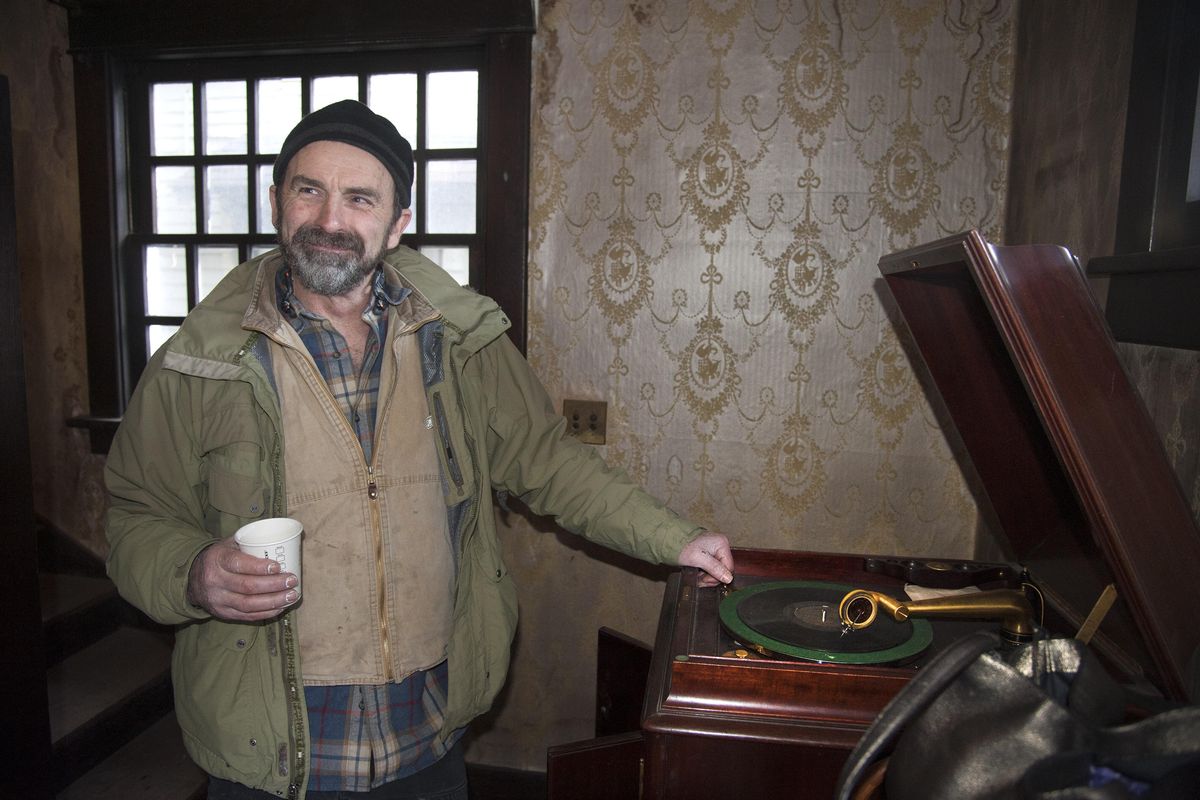Historic home linked to Shriners Hospital maintains its past – outside and in

Henry Pierce turned the crank on the old Victrola and moved the needle.
The air of the cold living room filled with the 1926 jazz song “Baby Face, Foxtrot” by Jan Garber and His Orchestra, and Pierce smiled.
“My grandmother and grandfather would have dances here,” he said, motioning to the open front room of the Eikenbary-Pierce House on Spokane’s South Hill. “They would roll up the rugs and play this thing.”
It’s easy to imagine the foxtrot being done in the old house, which was recently added to the historic registry by the Spokane City Council.
While weather-beaten and in disrepair, the home stands as a reminder of Spokane’s past, even if some neighbors have grumbled about the piles of construction equipment and supplies littered around the yard in the last few years.
The home was built in 1910, during a home-building boom Spokane likely will never replicate. And it was owned, at different times, by two men instrumental in the founding and success of Spokane’s Shriners Hospital for Children: Dr. Charles Eikenbary and Henry Pierce, the current homeowner’s grandfather.
Besides his work with the Shriners, Pierce’s grandfather was editor of the Spokane Daily Chronicle near the beginning of the last century. The home remains in his family nearly 100 years after he purchased it.
More recently, his grandson, Henry Pierce, has been slowly renovating the house since he acquired it following his father’s death in 2009 at the age of 89. It’s been slow going, but Pierce said he’s tried hard to preserve the house and what it stands for.
“I have a child,” Pierce said. “But this is my other child.”
Usually when a house is added to the registry, it’s just for the facade. In the Eikenbary-Pierce House’s case, the first-floor interior will be protected. If any changes are done to the wide-open living room, two entry foyers, dining room or inglenook, the city’s Historic Landmarks Commission must be consulted, according to a management agreement.
Megan Duvall, the city’s historic preservation officer, said the house has generated more interest than normal. When she put photos of the house on her department’s Facebook page, she garnered 200 new “likes” and the post reached an unprecedented 15,000 people.
“A lot of people have wondered, ‘What’s going on inside that house?’ ” Duvall said. “This pulls the curtain back a little bit.”
The Arts and Crafts home is a block east of Cliff Park, and it retains much of its original Craftsman features, including an open first floor, built-in bookcases and buffet-hutch, and “finely crafted, unadorned woodwork designs crafted in ebony-finished straight and curly fir,” according to the home’s application for the historic registry.
Pierce’s father, grandmother and grandfather moved into the home in 1923, when his father was just 3 years old. The following year, the Shriners Hospital for Crippled Children was opened in Spokane, the seventh in the nation. At the time, many diseases afflicted children that today seem vestiges of the past, such as polio, club foot and tuberculosis.
In 1924, Pierce, the Chronicle’s editor, was elected chairman of the board for the new hospital, a position he held for 35 years. He recruited Eikenbary as the hospital’s first orthopedic surgeon and chief of staff.
But before he hired Eikenbary, he bought the house from him. Both men lived in the Eikenbary-Pierce House, thus the name, though not at the same time. It was built beginning in 1909, at the end of a bustling decade in Spokane. In 1872, Spokane was founded by less than 50 people. In 1900, the city’s population grew to 25,000. Ten years later, about 100,000 people called the city home.
In 1913, Eikenbary purchased the home. Ten years later, he sold the home to Pierce, who lived there until his death in 1959. The current owner, Henry Pierce, lived in the house when he was a child and attended nearby Roosevelt Elementary.
Pierce purchased the house from his father’s estate for $160,000 and has invested about $50,000 into it since, which includes a new foundation under the north end of the house, a fresh coat of paint and a new roof.
Given its history, he hopes the Shriners, or some other charitable organization, is interested in the house and would use it to house visiting doctors or family members of patients. But he hasn’t approached anyone yet, so he’s unsure if such an idea is even possible.
Regardless, he said he just wants the home preserved.
“I’m not about making money,” he said. “I don’t really care to sell it.”
A picture of President Franklin Pierce hangs above the fireplace in a small nook with two original benches. (Pierce said the former president is a distant relative.) Judging by the temperature in the house, a fire hasn’t burned in a while, but Pierce said he’ll keep his family’s memory alive as long as he can.
“It preserves the heritage of my family’s efforts in Spokane,” he said. “Even if I don’t finish, someone will.”